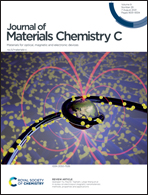Modulating surficial oxygen vacancy of the VO2 nanostructure to boost its electromagnetic absorption performance†
Abstract
Endowing a transition metal oxide (TMO) with oxygen vacancy is an efficient strategy to tune its electronic structure and electric properties. In this work, we put forward an exquisite VO2–NaBH4 grinding treatment for the tuning of surficial oxygen vacancy of VO2 nanostructures under ambient conditions, and systematically investigate the electromagnetic absorption (EMA) properties of treated VO2. Electron paramagnetic resonance (ESR) spectroscopy and X-ray photoelectron spectroscopy (XPS) demonstrate that the formation of oxygen vacancy occurs via the reaction of H− in NaBH4 with surficial V–O–H of VO2. First-principles simulations and experimental results reveal the correlation between oxygen vacancy and electrical conductivity. It is found that the EMA performance of VO2 is closely associated with its oxygen vacancy content and can be efficiently regulated by tuning the mass ratio of VO2 and NaBH4. Enhanced electrical conductivity and improved polarization relaxation are thought to be the main reasons for the enhanced EMA performance. This research provides a new idea for the tuning of surficial oxygen vacancy as well as the design of novel EMA materials.



 Please wait while we load your content...
Please wait while we load your content...